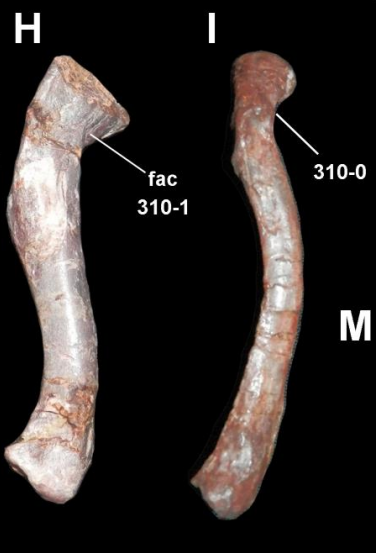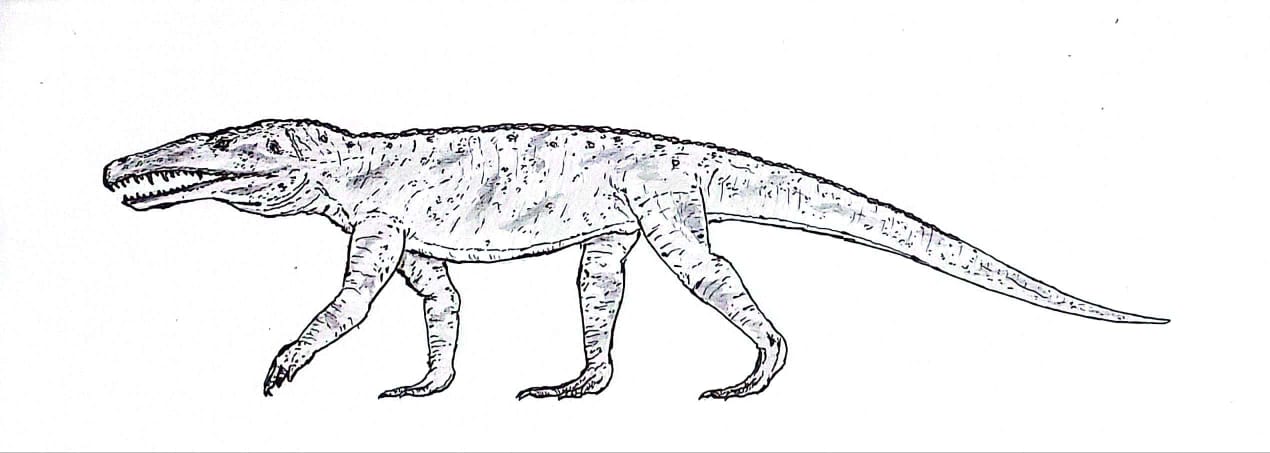|
Chañares Formation
The Chañares Formation is a Carnian-age geologic formation of the Ischigualasto-Villa Unión Basin, located in La Rioja Province, Argentina. It is characterized by drab-colored fine-grained volcaniclastic claystones, siltstones, and sandstones which were deposited in a fluvial to lacustrine environment. The formation is most prominently exposed within Talampaya National Park, a UNESCO World Heritage Site within La Rioja Province. The Chañares formation is the lowermost stratigraphic unit of the Agua de la Peña Group, overlying the Tarjados Formation of the Paganzo Group, and underlying the Los Rastros Formation. Though previously considered Ladinian in age, U-Pb dating has determined that most or all of the Chañares Formation dates to the early Carnian stage of the Late Triassic.Kent et al, 2014, p.7959 The Chañares Formation has provided a diverse and well-preserved faunal assemblage which has been studied intensively since the 1960s. The most common reptiles were ... [...More Info...] [...Related Items...] OR: [Wikipedia] [Google] [Baidu] |
Geologic Formation
A geological formation, or simply formation, is a body of rock having a consistent set of physical characteristics ( lithology) that distinguishes it from adjacent bodies of rock, and which occupies a particular position in the layers of rock exposed in a geographical region (the stratigraphic column). It is the fundamental unit of lithostratigraphy, the study of strata or rock layers. A formation must be large enough that it can be mapped at the surface or traced in the subsurface. Formations are otherwise not defined by the thickness of their rock strata, which can vary widely. They are usually, but not universally, tabular in form. They may consist of a single lithology (rock type), or of alternating beds of two or more lithologies, or even a heterogeneous mixture of lithologies, so long as this distinguishes them from adjacent bodies of rock. The concept of a geologic formation goes back to the beginnings of modern scientific geology. The term was used by Abraham Gottlob ... [...More Info...] [...Related Items...] OR: [Wikipedia] [Google] [Baidu] |
Claystone
Mudrocks are a class of fine-grained siliciclastic sedimentary rocks. The varying types of mudrocks include siltstone, claystone, mudstone and shale. Most of the particles of which the stone is composed are less than and are too small to study readily in the field. At first sight, the rock types appear quite similar; however, there are important differences in composition and nomenclature. There has been a great deal of disagreement involving the classification of mudrocks. A few important hurdles to their classification include the following: # Mudrocks are the least understood and among the most understudied sedimentary rocks to date. # Studying mudrock constituents is difficult due to their diminutive size and susceptibility to weathering on outcrops. # And most importantly, scientists accept more than one classification scheme. Mudrocks make up 50% of the sedimentary rocks in the geologic record and are easily the most widespread deposits on Earth. Fine sediment is ... [...More Info...] [...Related Items...] OR: [Wikipedia] [Google] [Baidu] |
Archosaur
Archosauria () or archosaurs () is a clade of diapsid sauropsid tetrapods, with birds and crocodilians being the only extant taxon, extant representatives. Although broadly classified as reptiles, which traditionally exclude birds, the cladistics, cladistic sense of the term includes all living and extinct relatives of birds and crocodilians such as non-avian dinosaurs, pterosaurs, phytosaurs, aetosaurs and rauisuchians as well as many marine reptile#Extinct groups, Mesozoic marine reptiles. Modern paleontologists define Archosauria as a crown group that includes the most recent common ancestor of living birds and crocodilians, and all of its descendants. The base of Archosauria splits into two clades: Pseudosuchia, which includes crocodilians and their extinct relatives; and Avemetatarsalia, which includes birds and their extinct relatives (such as non-avian dinosaurs and pterosaurs). Older definitions of the group Archosauria rely on shared morphology (biology), morphological ch ... [...More Info...] [...Related Items...] OR: [Wikipedia] [Google] [Baidu] |
Gualosuchus
''Gualosuchus'' is an extinct genus of proterochampsian archosauriform from the Middle Triassic Chañares Formation of Argentina Argentina, officially the Argentine Republic, is a country in the southern half of South America. It covers an area of , making it the List of South American countries by area, second-largest country in South America after Brazil, the fourt .... The type and only species is ''Gualosuchus reigi'', named by paleontologist Alfred Romer in 1971. Its skull length is 40 cm long making it quite a large proterochampsids. ''Gualosuchus'' also said to have a more robust humerus and tibia compared to other proterochampsids. References Proterochampsia Middle Triassic reptiles of South America Triassic Argentina Fossils of Argentina Chañares Formation Fossil taxa described in 1971 Taxa named by Alfred Romer Prehistoric reptile genera {{Triassic-reptile-stub ... [...More Info...] [...Related Items...] OR: [Wikipedia] [Google] [Baidu] |
Tropidosuchus
''Tropidosuchus'' is an extinct genus of carnivorous archosauriforms from the Middle Triassic period (Anisian to Ladinian stage). It is a proterochampsid which lived in what is now Argentina. It is known from the holotype PVL 4601, which consists of partial skeleton. It was found in the Chañares Formation and its type locality is the Chañares River. It was first named by A. B. Arcucci in 1990 and the type species In International_Code_of_Zoological_Nomenclature, zoological nomenclature, a type species (''species typica'') is the species name with which the name of a genus or subgenus is considered to be permanently taxonomically associated, i.e., the spe ... is ''Tropidosuchus romeri''. References Proterochampsia Ladinian genera Middle Triassic reptiles of South America Triassic Argentina Fossils of Argentina Chañares Formation Fossil taxa described in 1990 Prehistoric reptile genera {{triassic-reptile-stub ... [...More Info...] [...Related Items...] OR: [Wikipedia] [Google] [Baidu] |
Chanaresuchus
''Chanaresuchus'' is an extinct genus of proterochampsid archosauriform. It was of modest size for a proterochampsian, being on average just over a meter in length. The type species is ''Chanaresuchus bonapartei'' was named in 1971. Its fossils were found in from the early Carnian-age Chañares Formation in La Rioja Province, Argentina . ''Chanaresuchus'' appears to be one of the most common archosauriforms from the Chañares Formation due to the abundance of specimens referred to the genus. Much of the material has been found by the La Plata-Harvard expedition of 1964–65. ''Chanaresuchus'' is the most well-described proterochampsid in the subfamily Rhadinosuchinae. A second proposed species, ''C. ischigualastensis'', was named in 2012 from the late Carnian-age Ischigualasto Formation, was briefly assigned to ''Chanaresuchus'' before being moved to its own genus '' Pseudochampsa'' in 2014. ''C. bonapartei'' has been reported from the Santa Maria Formation in Brazil, but t ... [...More Info...] [...Related Items...] OR: [Wikipedia] [Google] [Baidu] |
Proterochampsidae
Proterochampsidae is a family of proterochampsian archosauriforms. Proterochampsids may have filled an ecological niche similar to modern crocodiles, and had a general crocodile-like appearance. They lived in what is now South America in the Middle and Late Triassic. Description Proterochampsids have long, crocodile-like skulls. The posterior portion of the skull is wide while the snout is very narrow. Most proterochampsids also have downturned snouts. Like many early archosauriforms, they also have dermal armour. Proterochampsids have small holes called dorsal fenestrae at the top of their skulls. Unlike other early archosauromorphs, they do not have a parietal foramin, which in many reptiles holds a parietal eye. The postorbital bones behind the eye sockets have thick, jagged crests. As another diagnostic feature of the group, the holes that allow the passage of the internal carotid artery through the braincase open at the sides of a bony projection called the basipterygoid ... [...More Info...] [...Related Items...] OR: [Wikipedia] [Google] [Baidu] |
Late Triassic
The Late Triassic is the third and final epoch (geology), epoch of the Triassic geologic time scale, Period in the geologic time scale, spanning the time between annum, Ma and Ma (million years ago). It is preceded by the Middle Triassic Epoch and followed by the Early Jurassic Epoch. The corresponding series (stratigraphy), series of rock beds is known as the Upper Triassic. The Late Triassic is divided into the Carnian, Norian and Rhaetian Geologic time scale, ages. Many of the first dinosaurs evolved during the Late Triassic, including ''Plateosaurus'', ''Coelophysis'', ''Herrerasaurus'', and ''Eoraptor''. The Triassic–Jurassic extinction event began during this epoch and is one of the five major mass extinction events of the Earth. Etymology The Triassic was named in 1834 by Friedrich August von Namoh, Friedrich von Alberti, after a succession of three distinct rock layers (Greek meaning 'triad') that are widespread in southern Germany: the lower Buntsandstein (colourful ... [...More Info...] [...Related Items...] OR: [Wikipedia] [Google] [Baidu] |
Uranium–lead Dating
Uranium–lead dating, abbreviated U–Pb dating, is one of the oldest and most refined of the radiometric dating schemes. It can be used to date rocks that formed and crystallised from about 1 million years to over 4.5 billion years ago with routine precisions in the 0.1–1 percent range. The method is usually applied to zircon. This mineral incorporates uranium and thorium atoms into its crystal structure, but strongly rejects lead when forming. As a result, newly-formed zircon crystals will contain no lead, meaning that any lead found in the mineral is radiogenic. Since the exact rate at which uranium decays into lead is known, the current ratio of lead to uranium in a sample of the mineral can be used to reliably determine its age. The method relies on two separate decay chains, the uranium series from 238U to 206Pb, with a half-life of 4.47 billion years and the actinium series from 235U to 207Pb, with a half-life of 710 million years. Decay routes Uranium decays to l ... [...More Info...] [...Related Items...] OR: [Wikipedia] [Google] [Baidu] |
World Heritage Site
World Heritage Sites are landmarks and areas with legal protection under an treaty, international treaty administered by UNESCO for having cultural, historical, or scientific significance. The sites are judged to contain "cultural and natural heritage around the world considered to be of outstanding value to humanity". To be selected, a World Heritage Site is nominated by its host country and determined by the UNESCO's World Heritage Committee to be a unique landmark which is geographically and historically identifiable, having a special cultural or physical significance, and to be under a sufficient system of legal protection. World Heritage Sites might be ancient ruins or historical structures, buildings, cities, deserts, forests, islands, lakes, monuments, mountains or wilderness areas, and others. A World Heritage Site may signify a remarkable accomplishment of humankind and serve as evidence of humanity's intellectual history on the planet, or it might be a place of grea ... [...More Info...] [...Related Items...] OR: [Wikipedia] [Google] [Baidu] |
Talampaya National Park
Talampaya National Park () is a National Parks of Argentina, national park located in the east/centre of La Rioja Province (Argentina), La Rioja Province, Argentina. It was designated a provincial reserve in 1975, a national park in 1997, and a UNESCO World Heritage Site in 2000. Location The park protects an area of the High Monte ecoregion. The park covers an area of , at an altitude of above mean sea level. Its purpose is to protect important archaeological and palaeontological sites found in the area. It has landscapes of great beauty, with flora and fauna typical of the mountain biome. The park is in a basin between the Cerro Los Colorados to the west and the Sierra de Sañagasta to the east. The landscape is the result of erosion by water and wind in a desert climate, with large ranges in temperature - high heat by day and low temperature at night, with torrential rain in summer and strong wind in spring. To the south, the park borders Ischigualasto Provincial Park, a pro ... [...More Info...] [...Related Items...] OR: [Wikipedia] [Google] [Baidu] |





